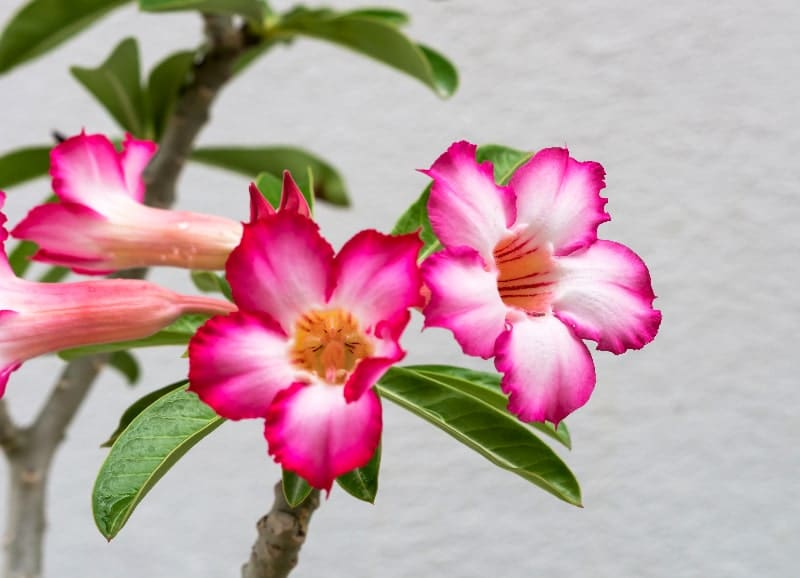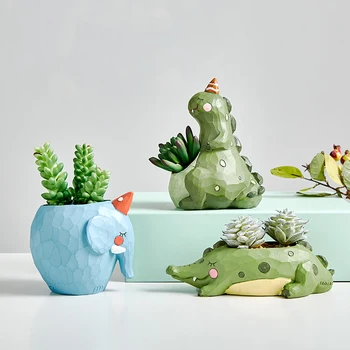Unique plants that are easy to grow and have fun with are widely popular amongst plant lovers. If you are a novice or an intrepid planter, Desert Rose is a perfect plant to start with.
They look great inside the interior container garden or when used as a patio display. Two essential care considerations for desert rose succulent include a location that gets full sunlight and well-drained soil.
Keep reading to learn more about desert rose plant and how to care for it.
Desert Rose Succulent, also called adenium obesum, it’s a striking plant with deep red flowers and succulent stems.
Desert Rose grows slowly, approximately only 12 inches each year. The thick succulent trunk coupled with Lucious and deep pink trumpeting flowers makes it a popular bonsai plant. Leaves are delicate.
As each part is unique, appropriate care is needed. Characterized by swollen stems resembling the bonsai tree, the plant offers bright flowers. Yet to bloom flowers feature tight clusters of narrow green leaves.
When growing inside your house, you have to be careful if you have pets and children. The sap is poisonous, and it’s strictly recommended to wash your hands immediately if you touch it when handling the plant.

Some interesting and important facts about the plant are highlighted below:
| Common Name | Sabi star, Impala lily, Desert Rose, & Mock Azalea |
| Botanical Name | Adenium Obesum |
| Family | Apocynaceae |
| Plant Type | Succulent |
| Mature Size | Height: 3.9 ft Width: 3.5 ft. |
| Sun Exposure | Abundant Sunlight For Most Parts of the day is required |
| Soil Type | Well-drained and Sandy |
| Soil pH | Acidic |
| Bloom Season | Summers |
| Flower Color | Red, Pink, Rose |
| Hardiness Zones | 11 & 12 |
| Native Region | Madagascar, Middle East and Africa. |
| Toxicity | Toxic to both humans and pets |
Although tending is quite simple, you need to take adequate care of the plant. Proper water management and abundant sunlight are two most essential requirements. One reason it’s a popular plant grown indoors is that desert rose requires consistent warm temperatures.
In the blooming season i.e., the summer months, it is full of vibrant red, rose and pink flowers. Adding elegance to it are the bright green leaves. It becomes dormant in winters and drops its foliage and flowers.
Acclimated to dry and desert-like conditions, the desert rose plant requires a well-draining gravelly cactus or sandy soil. Preferably you should opt for a soil with a neutral to acidic pH value of around 6.0.
As the plant requires abundant sunlight for most parts of the day, you must place it in a corner that receives ample sunlight for a considerable day’s duration. A window or patio in the southern part of your house is ideal. For people living in suitable conditions to grow the plant outdoors, placing it in a garden where taller plants don’t shade is the best spot. However, some protection from the scorching noon heat is also required.
Hence, ideally, a spot that remains warm for the entire day is a perfect growing condition for your plant. Technically speaking, exposure to cooler temperatures below 50 degrees Fahrenheit isn’t good for desert rose plants to grow. Temperatures ranging between 65 to 90 degrees Fahrenheit provides the best thriving conditions. You need not worry about the humidity in warm conditions as desert rose is accustomed to the hot and dry climate.
Depending on weather conditions, temperature, and the season, the watering requirements vary. In the growing season, i.e. summer and spring, you need to keep the soil moist and not saturated. Periodic checks and allowing it to dry are entirely necessary before rewatering.
The container used for planting should have ample drainage holes as desert rose is susceptible to rot in moist conditions. In dormant stages, i.e. fall or winter, moisture levels reduce drastically and require minimal watering. By checking its trunk, you can ascertain if the plant receives enough water in the growing season. Suppose you observe a swollen, thick truck, it’s an indication that the plant is well-hydrated.
To increase the nutrient dosage, you must feed the desert rose plant with liquid fertilizers. You should do this once every month during the growing season. Refrain from using fertilizers in the dormant period.
You can grow a desert rose from seeds and branch cuttings. When growing from the branch cutting results in a bulbous trunk plant. Below we have a step-by-step guide for propagating the plant.
After the roots fill the container, the plant becomes root bound and repotting is required. You might need to do this every year, but you may keep it in the current container if you don’t want it to grow further. The growth of desert rose slows down if it’s kept rootbound—late winters or before the new growing season is perfect for repotting.
While repotting the succulent, the soil should be arid before gently removing the plant. Remove old soil from the roots along with dead or rotted roots. If you notice bruises or cuts, you may apply an antibacterial or fungicide solution. Place the entire plant inside the new pot and backfill with a potting mix. Spread the roots while you repot. Allow it to dry for a week and reduce the shock to the plant. Later, water it and ensure that water drains out thoroughly.

Some common questions might come to your mind while you have gone through our article. We have answered some below:
Growing in the wild, Desert Rose is commonly found in areas that receive full sunlight. Hence, direct sunlight is preferable, especially during the active growth phase.
Desert Rose is a common plant grown indoors if provided with ideal growing conditions.
The sap of the plant is poisonous, and never let your pets or children come in contact with it. Wash your hands immediately if you or others touch them with bare hands.
Desert Rose has grown in popularity for its attractive tree and bonsai shapes. It grows into a beautiful plant and has excellent adaptability features. It features a long-flowering period; it is drought tolerant, requires minimal watering, and remains colorful.
Being a bonsai plant, it also comes with several medicinal benefits, such as its used to treat wounds and soles of the feet, take care of your skin, relieve pain, treat toothaches, and treat ulcers.
You may enjoy these related articles:




We provide a platform supported by gardening enthusiasts to share unique experience and knowledge.
We’ve pledged 5% of sales to the program which help more families have opportunity to have garden.
Every action we make has an impact on planet. Learn more about Million Compost Movement.
Join facebook community to connect, share passion and get support when you need.
Keep in mind that we may receive commissions when you click our links and make purchases. However, this does not impact our reviews and comparions. We try our best to keep things fair and balanced, in order to help you make the best choice for you.
As an Amazon Associate, we earn from qualifying purchases.
Sign up for gardening tips, activism awareness, exclusive offers and more!
© Garden Guidepost

Gardening tips, activism awareness, exclusive offers and more!